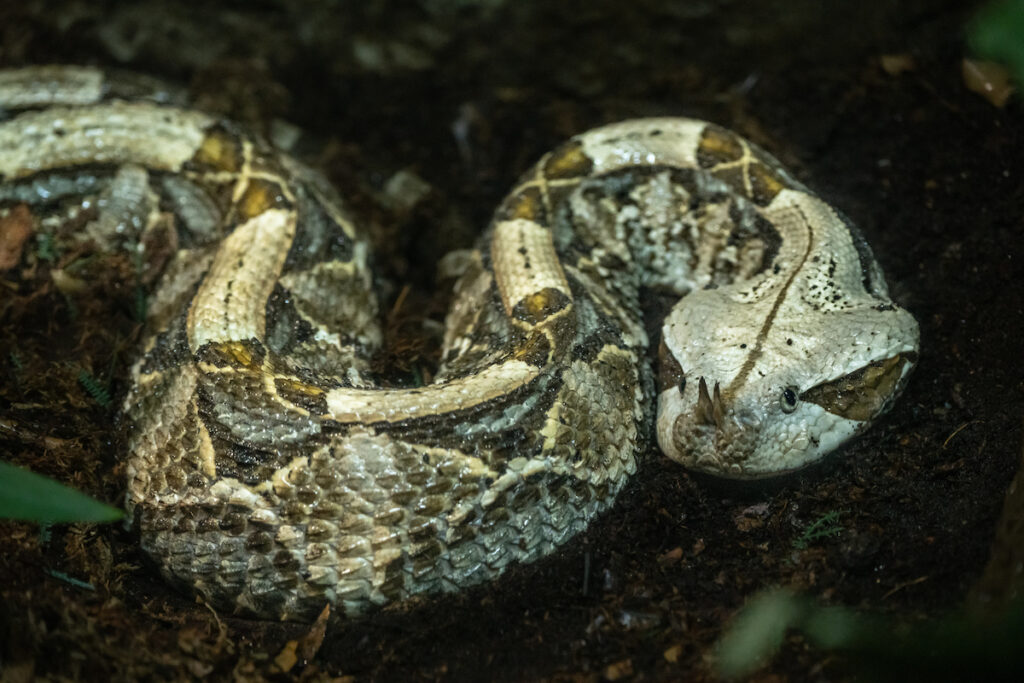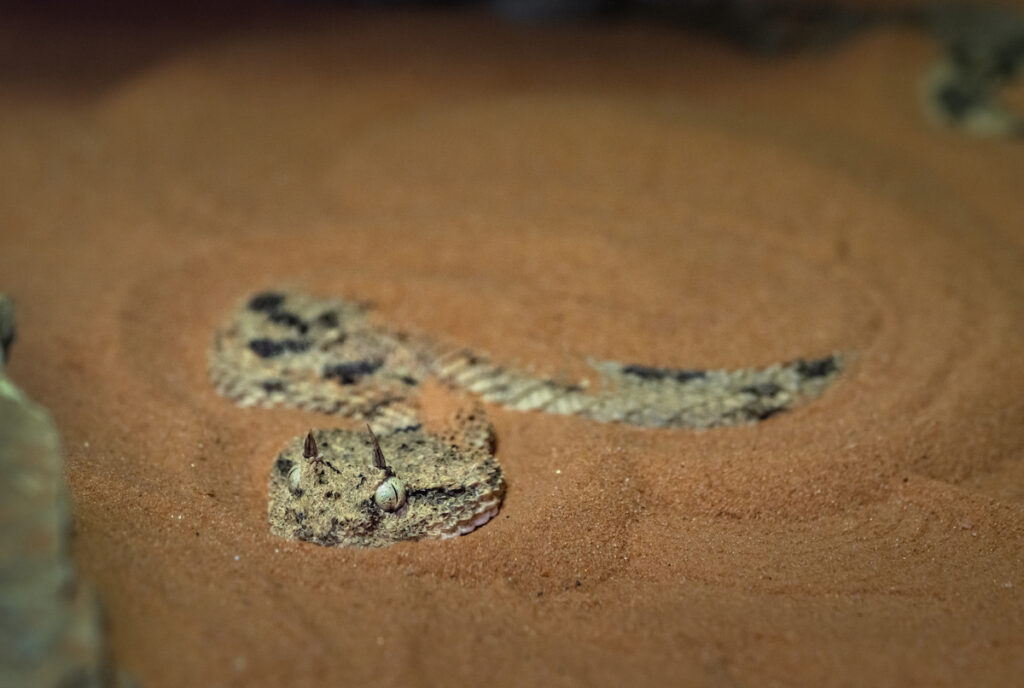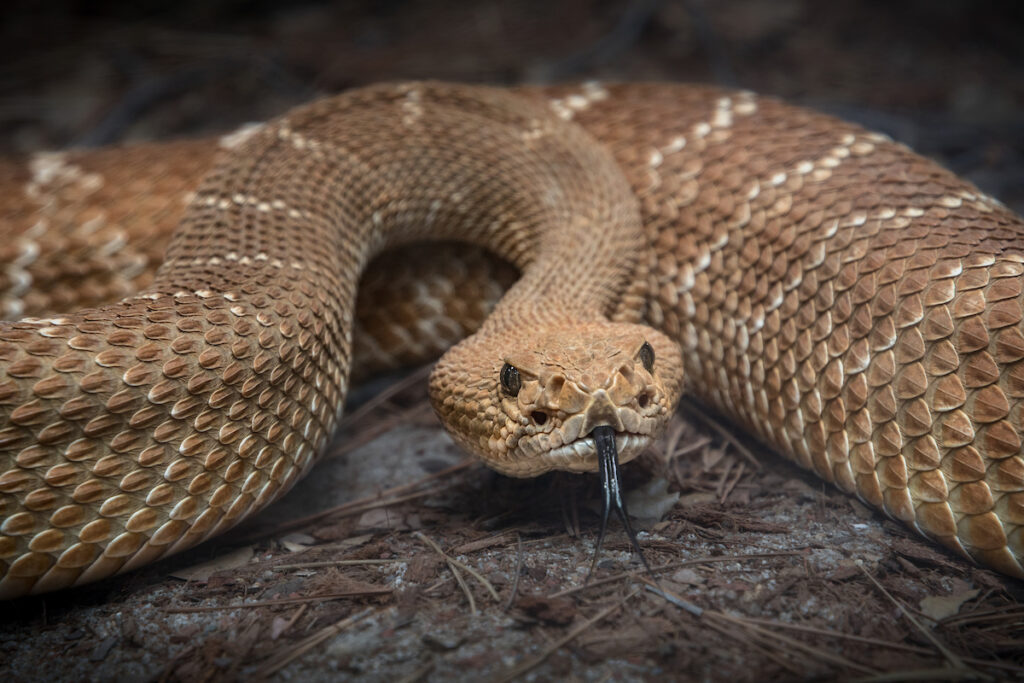by Alex Oliver
Venom Breakdown
Venom has evolved as a tool for snakes to immobilize and digest their food. It has a variety of different properties, and venomous snakes have a mix of different types of venom cocktails. Some have a neurotoxic component, which affects the nervous system. Some venoms have hemotoxic (affecting blood and tissue), some have myotoxic (affecting muscle), and some have cytotoxic (affecting cells) components.
If a snake’s venom is neurotoxic, it can block neurotransmitters—the chemical messages to organs—leading to organ failure. It can shut down the heart, lungs, and brain and can cause paralysis.
As Curator of Ectotherms Byron Wusstig explains, “The hemotoxic molecules in snake venom are doing things like preventing blood from clotting, creating extreme swelling, and causing tissue damage. That’s another property of snake venom: in most cases, a snake’s venom doesn’t just have one component or the other; they’ve got a mix of many.”
Within a single species, individuals on one side of a mountain range may have a certain make-up to their venom while snakes on the other side have a different one. They evolve to be able to eat and acquire different prey that have different sensitivities, and snake venom can change as the snake grows older. Many snakes go through what’s called an ontogenetic shift in their diet. They’ll start out eating one prey item, like a lizard, and as they age, they transition to something larger, like a mammal. The type of venom that’s required to quickly dispatch a lizard can be different than the type of venom that’s required to take down a mammal. Primary prey type affects venom composition.

There’s a lot of variability in venomous snake bites. There are instances when a snake can deliver a “dry bite,” meaning no venom is injected at all. Then there are other instances where the snake is really agitated and injects a large percentage of its venom. And, there’s everything in between. Snakes have control over how much venom they inject, and individual humans have different reactions as well. Just like a person may have an allergy to a bee sting, some individuals may have specific allergies to components of certain snake venom, making the effects of the bite worse.
The reason that humans have such a bad reaction to snake venom is that we haven’t evolved the resistance over time. Venom is a sort of cat-and-mouse game of evolution between the prey and the predator, where some natural prey species have co-evolved with venomous snakes.
A brown tree snake’s venom, for example, is extremely lethal to birds and lizards but has minimal effects with humans. Venom that has evolved to subdue mammalian prey is typically the most dangerous to people. “Generally speaking, the closer we are evolutionarily to the targeted prey base of that species, the more toxic their venom is to us as humans,” says Wusstig.
Why So Toxic?
Venom serves multiple roles. For snakes, the primary function is to acquire prey, and the secondary role is to start digestion. Many vipers bite and release their food in order to activate both of these functions. If a rattlesnake bites a ground squirrel, that ground squirrel runs away and slowly perishes, but the snake is not worried; it can track the squirrel by smell. What it smells is not only the squirrel but a protein called a “disintegrin.” Vipers evolved with disintegrins in their venom that aren’t very toxic to the prey item, allowing the quarry to run away after being bitten.

The snake has such a complex sensory organ that it can smell the difference between its own disintegrins and another snake’s disintegrins. It leaves a scent trail that the rattlesnake can track, and by the time the snake finds the hiding squirrel, the decomposition process has already started. A venomous snake prefers to digest a prey item that it has envenomated, rather than relying on the digestion process in its stomach alone. “That’s something that we’ve even seen at the Zoo. In some of the vipers that we work with, we found that if the snake will strike it and then let go, it increases their likelihood of consuming the food,” says Wusstig.
Safety Protocols
When working with venomous reptiles, safety is key. The animals in the LAIR–although they have the potential to be deadly–are very safe to work with if you follow the rules. The Zoo has regimented safety protocols, and LAIR staff practice them regularly, including carrying out mock scenarios in real time. “We can get from a simulated bite to walking through the ER doors very quickly,” says Wusstig.
A major part of the Zoo’s safety considerations is antivenom.

Antivenom is a medical product for the treatment of venomous snake bites. It is made at venom research laboratories by extracting venom from live, venomous snakes. A small amount of that venom is injected into a host animal, often an equine. The amount is not enough to make horses ill or to harm them in any way; it is only enough to produce an immune response in the animal’s body. After a blood draw, the small proteins responsible for eliminating venom from the animal’s body are extracted and refined, eventually creating the antivenom that doctors would use for treatment of a snake bite.
“At the Zoo, we’re not just working with our local rattlesnake species,” Wusstig says. “We can’t just go to the hospital for treatment of a Gaboon viper or a green mamba bite, because they will not stock the product that we need. We’re working with snakes from all over the planet, so we must stock antivenom accordingly.” That means importing our own antivenom and storing it at the LAIR.
The Zoo’s Antivenom
There are different types of antivenom. At top level, they can be categorized into two groups: monovalent or polyvalent. Monovalent antivenom is made from the venom of a single species of venomous snake. Polyvalent antivenom is made from the venom of more than one species, giving the Zoo a wider range of snakes we can work with.
The Zoo currently stocks antivenoms to cover all the different species we work with. We have one product that works on Middle Eastern and North African venomous snakes, one that works on sub-Saharan African snakes, one that’s for Asian snakes, and one for New World pit vipers. That antivenom is imported from all over the world.


The L.A. Zoo is not an island functioning on its own regarding antivenom stock. Zoos accredited by the Association of Zoos and Aquariums (AZA) have access to the Antivenom Index, an online database organized and maintained by the AZA in collaboration with the American Association of Poison Control Centers. The Antivenom Index is used to help poison control center staff locate appropriate antivenom as needed. For example, a physician in Toledo can request that their local poison control center look up the location of appropriate antivenoms for a green mamba near their office; an individual with an illegal Gaboon viper cannot request a store of antivenom for personal use.
If an ounce of prevention is worth a pound of cure, then the LAIR’s antivenom refrigerator is worth its weight in gold.
Worth the Risk?
Antivenom is not a one-size-fits-all magic bullet. Because of the variability of effects on individuals, physicians may administer one vial or 20; it depends on how an individual reacts and how much venom is circulating in the bloodstream.
Aside from the direct physiological and medical responses that the human body has to venomous snake bites, there’s an extraordinary monetary cost as well. The cost of treating a venomous snakebite can swing wildly—from as little as $200 to a jaw-dropping $100,000 or more. Why such a massive range? A lot of factors come into play, like:
- The snake: If it’s something like a black mamba (illegal in California), antivenom will be hard to find—and expensive.
- Emergency transport: Taking a medevac out of a remote area may be necessary.
- Where you were bitten: A bite near an artery or muscle is more serious and costly to treat.
- Dry bite vs. full venom yield: It’s not only about the location—it’s also about the amount of venom injected (“dry bites” result in much less cost, regardless of location).
- Delayed treatment: If you wait too long to get help, things can get a lot worse (and pricier). There’s a reason people say “time is tissue.”
- Allergic reactions: If your body doesn’t play nice with the venom or antivenom, you might need additional treatments.

“Being bitten by a rattlesnake is an incredibly expensive mistake, and I say mistake and not accident, because most snake bites, at least here in the U.S., involve people that are intentionally interacting with the snake in one way or another,” says Wusstig. “They’re working with the snake, they’re attempting to move the snake, they’re pestering the snake. Rattlesnakes are shy, secretive creatures that would much rather be left alone, but if they’re provoked they will stand their ground and defend themselves.”
If you see that rattlesnake on the hiking trail, it’s best just to take a step back and leave it alone.
The Medical Significance of Venom
Venom may be bad news for prey, but because of the complexities of venom and how it interacts with different parts of the body, scientists have identified some components that are helpful to study for human drug research. Rattlesnake venom proteins and enzymes are being studied by biotech companies for possible cancer treatments and therapies. The active ingredient in the first ACE inhibitor, captopril, was originally derived from snake venom. The protein exendin-4, which is found in the venom of the Gila monster, was used to develop a weight loss drug and is currently being studied as a possible enhancer to additional drugs. Gila monster proteins are also being used to develop treatments for diabetes.
Venom is one of the most sophisticated adaptations in the animal kingdom–and another reason why snakes are so fascinating and worthy of our respect and admiration. On your next visit to the Zoo, stop by the LAIR to (safely) see some of these amazing animals up-close!

